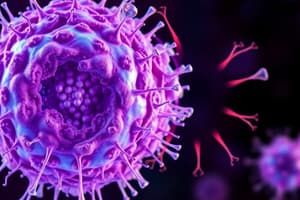Podcast
Questions and Answers
What is the primary function of the nucleus in a cell?
What is the primary function of the nucleus in a cell?
- Storage of materials
- Protein synthesis
- Intracellular digestion
- Control center of the cell (correct)
Which structure is responsible for synthesizing ribosomal subunits?
Which structure is responsible for synthesizing ribosomal subunits?
- Rough ER
- Nucleolus (correct)
- Golgi apparatus
- Nuclear envelope
What distinguishes bound ribosomes from free ribosomes?
What distinguishes bound ribosomes from free ribosomes?
- They synthesize lipids.
- They are involved in detoxifying drugs.
- They are attached to the endoplasmic reticulum. (correct)
- They float in the cytosol.
What is the primary role of the Golgi apparatus?
What is the primary role of the Golgi apparatus?
Which type of endoplasmic reticulum is responsible for lipid synthesis?
Which type of endoplasmic reticulum is responsible for lipid synthesis?
What is a key structural difference between prokaryotic and eukaryotic cells?
What is a key structural difference between prokaryotic and eukaryotic cells?
Which organelle is the primary site for cellular respiration?
Which organelle is the primary site for cellular respiration?
What is the fluid-filled inner compartment of the mitochondria called?
What is the fluid-filled inner compartment of the mitochondria called?
Which of the following functions is associated with chloroplasts?
Which of the following functions is associated with chloroplasts?
What does the endosymbiont theory suggest about mitochondria and chloroplasts?
What does the endosymbiont theory suggest about mitochondria and chloroplasts?
What is the primary role of the plasma membrane?
What is the primary role of the plasma membrane?
Which of the following is a characteristic of prokaryotic cells?
Which of the following is a characteristic of prokaryotic cells?
Which structure is commonly found in both plant and animal cells?
Which structure is commonly found in both plant and animal cells?
Flashcards are hidden until you start studying
Study Notes
Types of Cells
- Prokaryotic Cells: Include Bacteria and Archaea, lacking a nucleus and membrane-bound organelles, typically smaller and simpler.
- Eukaryotic Cells: Found in Protists, Fungi, Plants, and Animals; have a true nucleus and organelles, larger and more complex.
Prokaryote vs. Eukaryote
- Prokaryotes are considered primitive and smaller in size, while eukaryotes display complexity and increased size.
- Prokaryotic DNA is located in a nucleoid; eukaryotes contain DNA within a nuclear envelope.
Mitochondria
- Function as the site of cellular respiration.
- Structure consists of a double membrane, with the inner membrane folded into cristae for increased surface area aiding ATP production; the matrix is the fluid-filled inner compartment.
Chloroplasts
- Function as the site of photosynthesis.
- Contain thylakoids arranged in stacks (grana) and stroma filled with chlorophyll pigments to capture sunlight energy.
Endosymbiont Theory
- Proposes that mitochondria and chloroplasts originated from prokaryotic cells engulfed by ancestors of eukaryotic cells.
- Evidence includes their double-membrane structure, presence of ribosomes and DNA, and their ability to reproduce independently.
Cytoplasm
- The cytoplasm is the region between the nucleus and plasma membrane, encompassing the cytosol and embedded organelles.
- Found in all living organisms.
Plasma Membrane
- Provides a barrier between the cell and its extracellular environment, composed of a bilayer of phospholipids with embedded proteins.
- Considered likely the first cell structure.
Nucleus
- Acts as the control center of the cell, housing DNA and surrounded by a double membrane (nuclear envelope).
- Contains nuclear pores that regulate entry and exit, chromatin for genetic information, and a nucleolus for ribosomal subunit formation.
Ribosomes
- Essential for protein synthesis, made of ribosomal RNA and protein.
- Types include free ribosomes (for internal cell proteins) and bound ribosomes (attached to the ER for export proteins).
Endomembrane System
- Regulates protein transport within the cell and performs metabolic functions.
Endoplasmic Reticulum (ER)
- Rough ER: Studded with ribosomes for protein packaging and transport; involved in creating replacement membranes.
- Smooth ER: Lacks ribosomes; involved in lipid synthesis, carbohydrate metabolism, detoxification of drugs and poisons, and calcium ion storage.
Golgi Apparatus
- Responsible for the synthesis and packaging of materials for transport in vesicles and production of lysosomes.
- Consists of a series of flattened membrane sacs; has a cis face for receiving vesicles and a trans face for shipping vesicles.
Lysosomes
- Function in intracellular digestion, recycling cellular materials, and programmed cell death (apoptosis).
- Contain hydrolytic enzymes for breaking down macromolecules.
Vacuoles
- Membrane-bound vesicles primarily for storage of various materials such as food, water, minerals, pigments, and poisons.
Studying That Suits You
Use AI to generate personalized quizzes and flashcards to suit your learning preferences.




